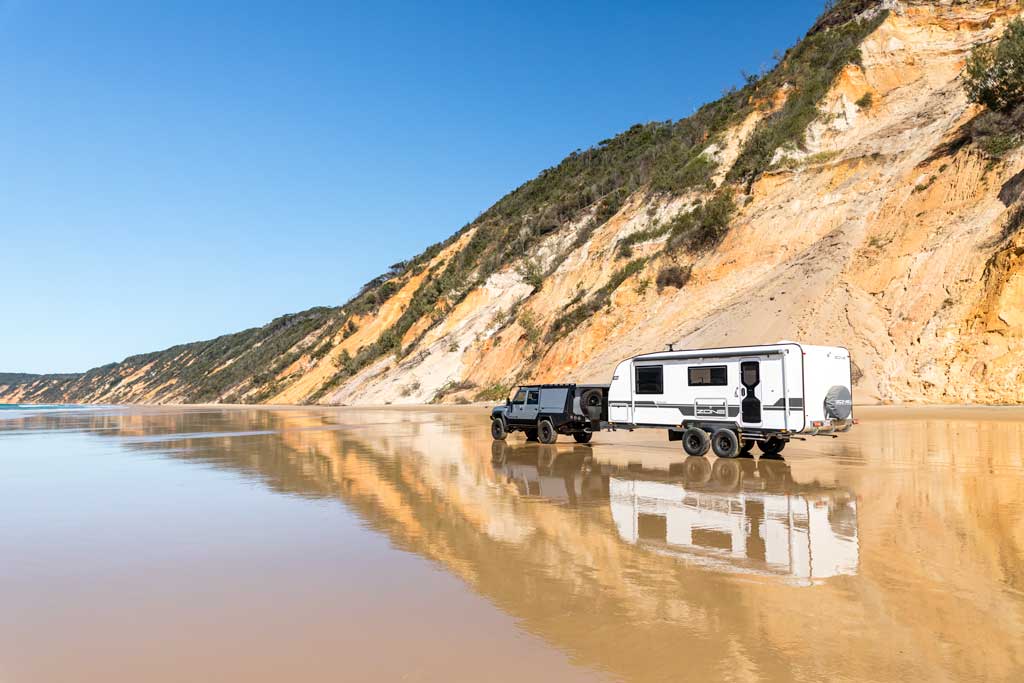
The new ZONE RV BASE Series is by no means a BASE Model. For those of you familiar with the ZONE RV Caravan brand, you will know that there is nothing ‘base model’ about any of their vans.
ZONE RV is at the cutting edge when it comes to materials and processes used in the manufacture and construction of their caravans and hard-bodied campers.
BASE, in this regard, refers to “BASE CAMP.” A van you can tow anywhere in Australia and set up for a couple of weeks while you explore an area and return to “BASE” each night.
Table of Contents
FIRST IMPRESSIONS OF THE ZONE RV BASE SERIES
Even though the BASE is a brand new model in the ZONE RV line up, you can tell straight away that it’s a ZONE.
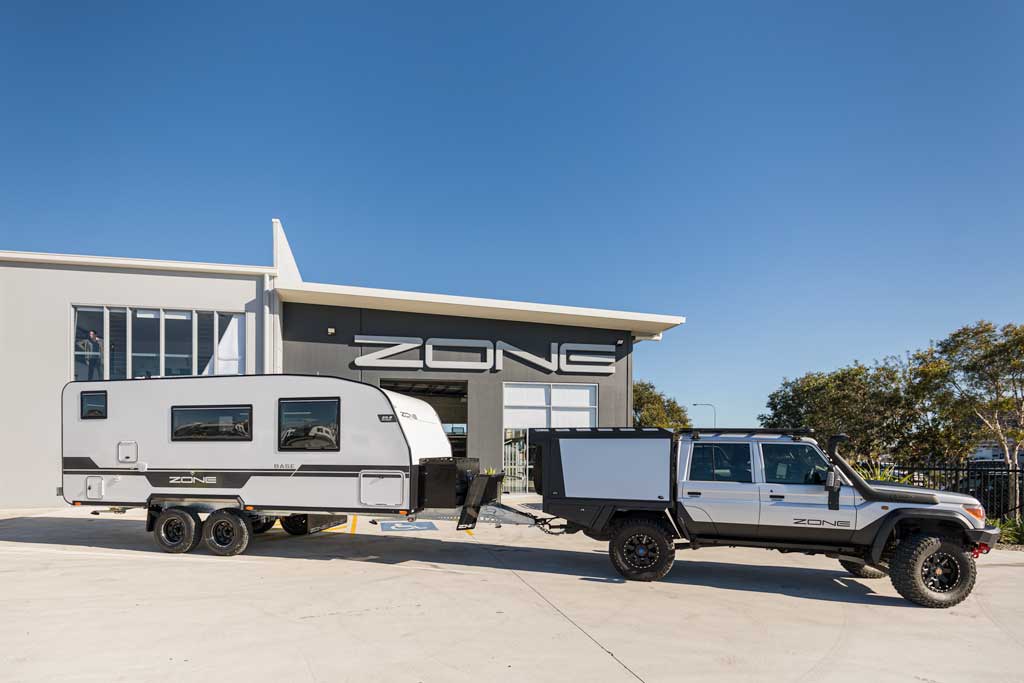


First up, there’s no mistaking the unique drawbar design that is shared across all ZONE RV models. There’s also the high stance for maximum off-road clearance.
Then there is the sleek, all composite body with understated decals.
While the new BASE Series is a new direction for the team at ZONE, there is no doubt that this new build shares a lot of the same DNA.
TOWING THE ZONE RV BASE
The test loop that we chose for our day out for testing the BASE had a little bit of everything. We started on the bitumen and ended up on the sand. Here is how it performed.
ZONE ONROAD
Leaving ZONE HQ at Coolum, on Queensland’s Sunshine Coast, we hit the Sunshine Motorway on our way north towards Tewantin. With a TARE of 2420kg, the BASE was barely noticeable thanks to the pulling power of the Dual Cab V8 Cruiser.
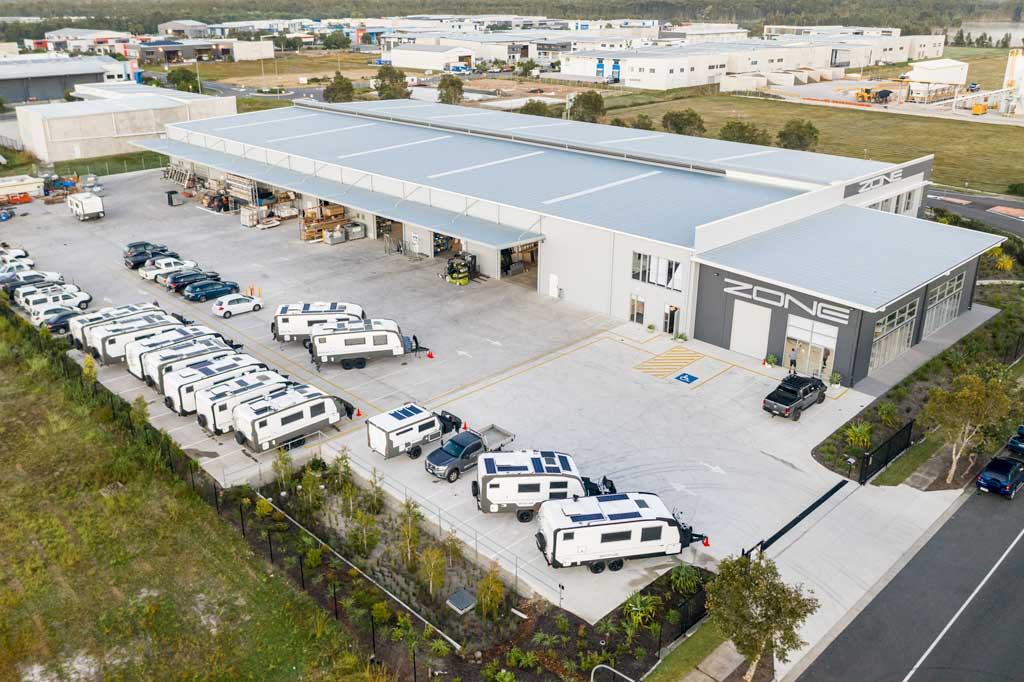


This stretch of road, features 100km/h sections are broken up by several roundabouts, before ending up in the small town centre of Tewantin. This first hit out gave me a good indication of how well the van handles typical bitumen driving.
Secondary bitumen roads were encountered as we made our way towards the dirt roads to the west of Lake Cootharaba.
ZONE OFFROAD
Bitumen gave way to well-maintained gravel sections that wove their way amongst pockets of sub-tropical rainforest.
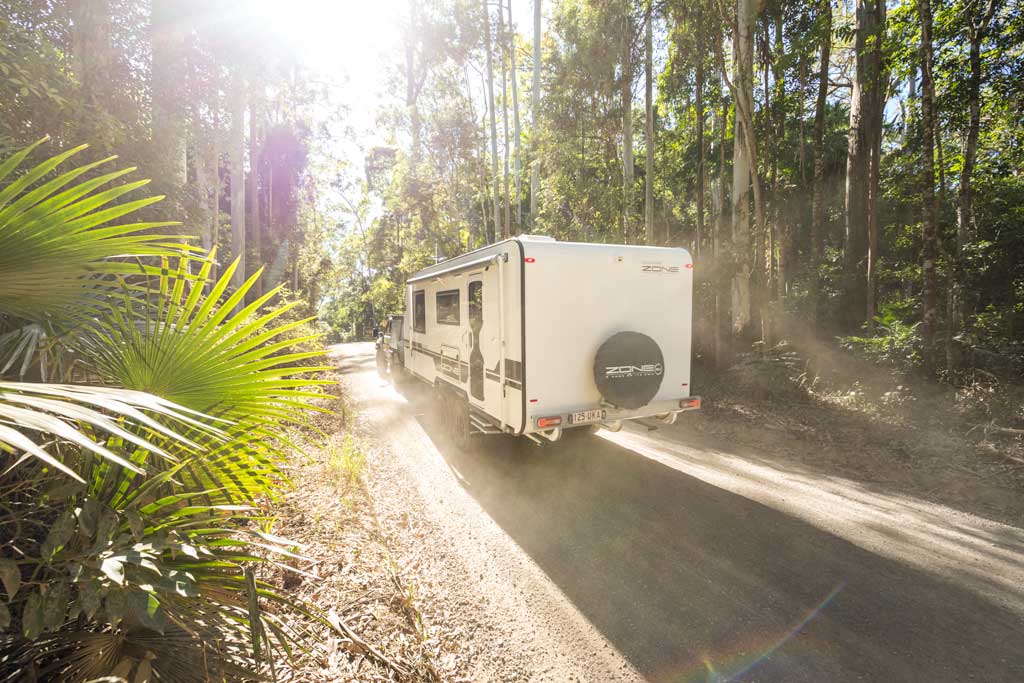


These were soon replaced by dirt roads through rows and rows of pine trees as the turnoff to Harrys Hut approached.
With the roads becoming rougher, we stopped to let some air out of the tyres, before hitting Cooloola Way. This section of the road deteriorates further and is designated as a ‘Dry Weather Only’ road.
Dropping our pressures ensured that our time spent traversing Cooloola Way passed without issue. Varied terrain and road surfaces were encountered before a surprise water crossing through the upper reaches of the Noosa River was tackled.
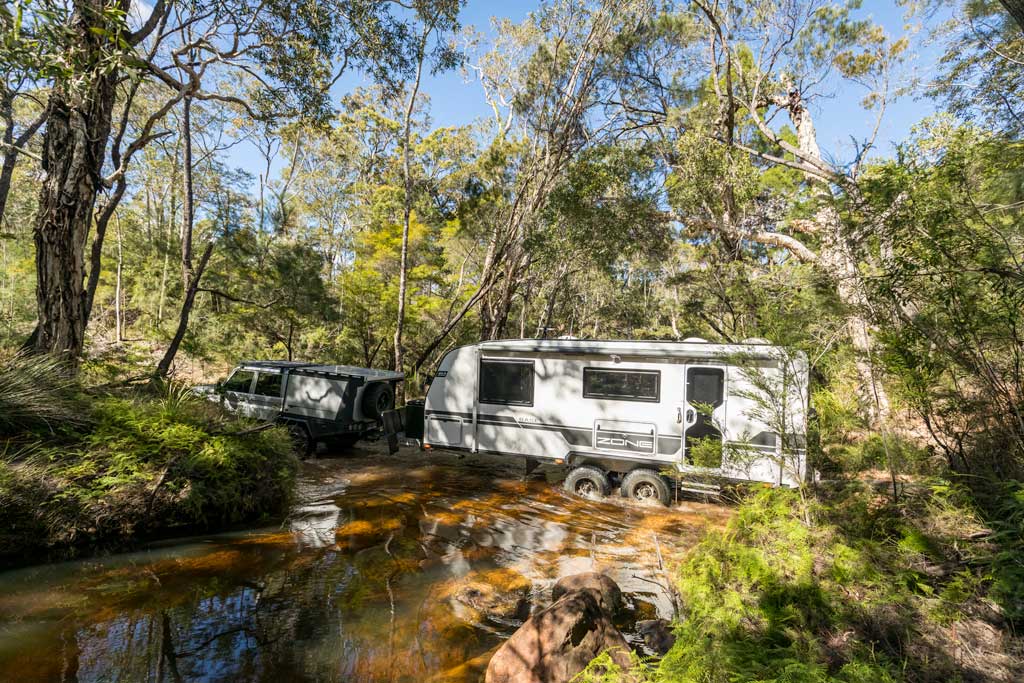


Our next obstacle was the sand of Rainbow Beach.
This proved to be no problem as the tide was on its way out. This gave us a great run on the hard sand south towards Double Island Point and the Coloured Sands.
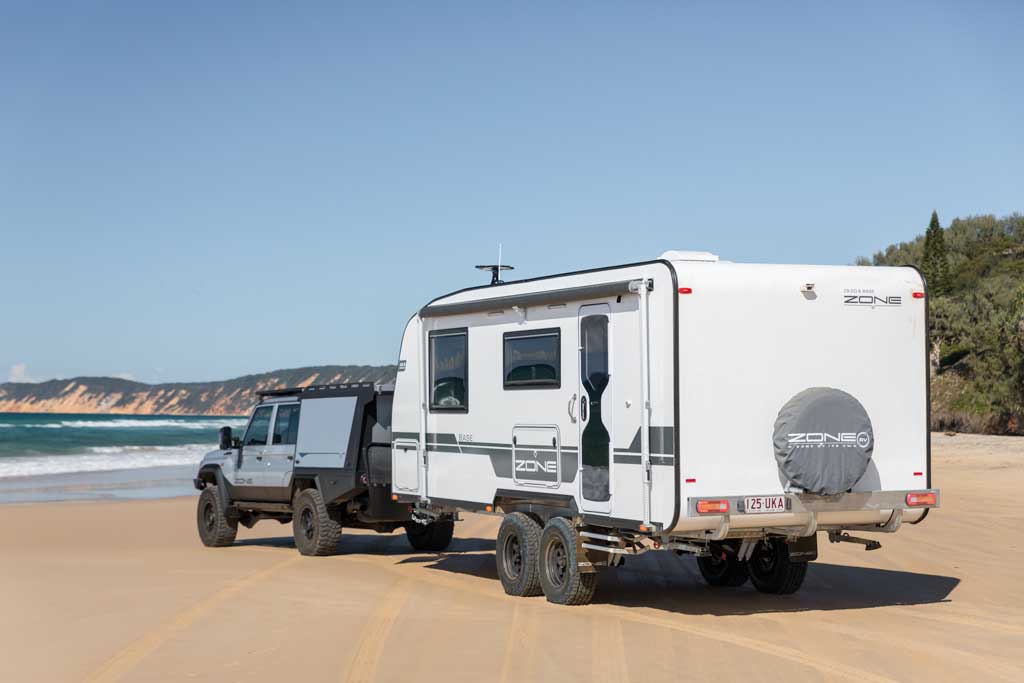


Over every surface, both on and off-road, the BASE performed flawlessly. Even the soft sand of the cuttings proved no problem.
THE BUILD PROCESS
Simplicity was a key design focus for the team at ZONE Caravans with the new BASE Series. While the new BASE Series shares a lot of similarities to the rest of the ZONE RV range, there are also some little differences.
Let’s start with the chassis.
CHASSIS
As mentioned previously, the BASE uses the same chassis that can be found under all ZONE RV vans. Hot dipped galvanising is preferred in favour of the Raptor coating used on other models.
The 6” chassis rail runs from front to back, while non-structural, CNC folded cross members keep weight down while still offering optimal strength. A DO35 hitch from Cruisemaster provides the articulation required by a serious off-road van.
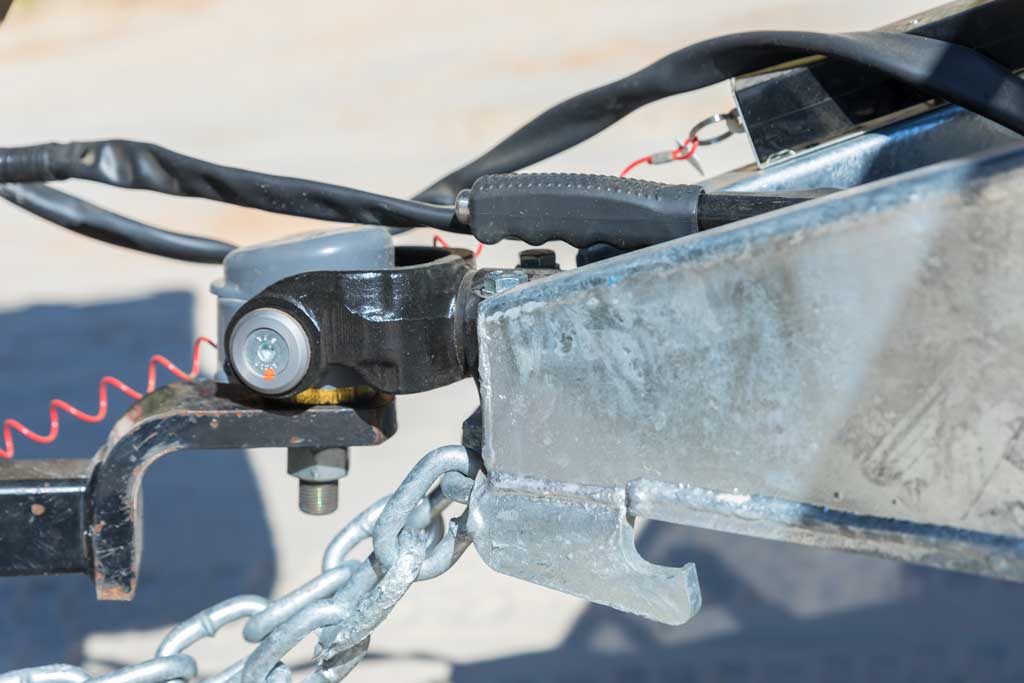


SUB-FLOOR
A single piece fibreglass panel is bonded to the chassis and cross members below. There are no screws or bolts used.
When the floor panel arrives at the factory, it has already been CNC routed for all service penetrations. All fittings are recessed into the panel for maximum protection. The penetrations are all sealed to ensure no dust or water ever makes its way inside the van.
Just like in all other ZONE RV caravans, the BASE utilises an automotive grade wiring harness that is tailor made for each van. This factory style loom comes fully sheathed and is protected underneath the van by running through a PVC pipe. A proprietary loom makes install, and diagnosing a fault a far easier task.
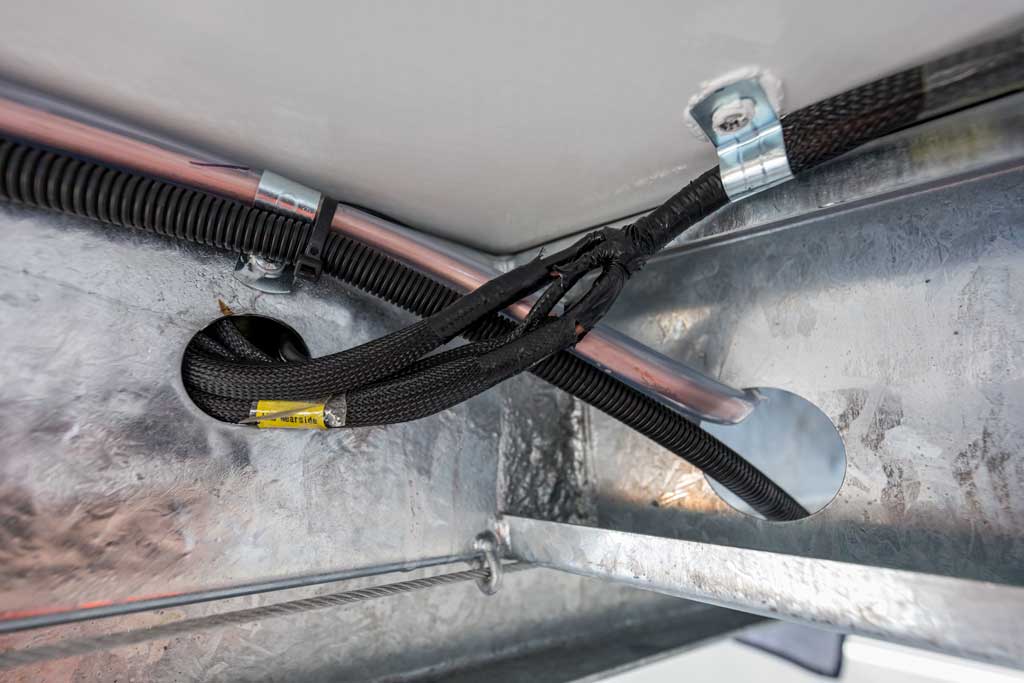


All other wiring, plumbing and gas lines are tied up high and run along chassis rails or behind cross members. This minimises the chance of potential damage from stray rocks or sticks.



The water tanks, which are tested prior to install, are protected by an aluminium checker plate shroud. For optimal weight distribution, they are mounted over the axles. Standard fitment to the BASE is a 90L fresh water and 100L grey water tank.
An extra water tank, or two, would be the first box ticked when adding extras to the BASE.
BODY
The best way to describe how a ZONE caravan is made is from the ‘inside out’. The BASE is no different.
Once the sub-floor has been completed, the full-composite cabinetry and furniture are bonded to the floor. This creates a very strong and robust structure.
Voids and cavities designed into the cabinets are utilised for the running of wiring and plumbing. This creates an exceptionally neat finish. In the event of an upgrade or if servicing is required, access panels inside the cabinets are provided.
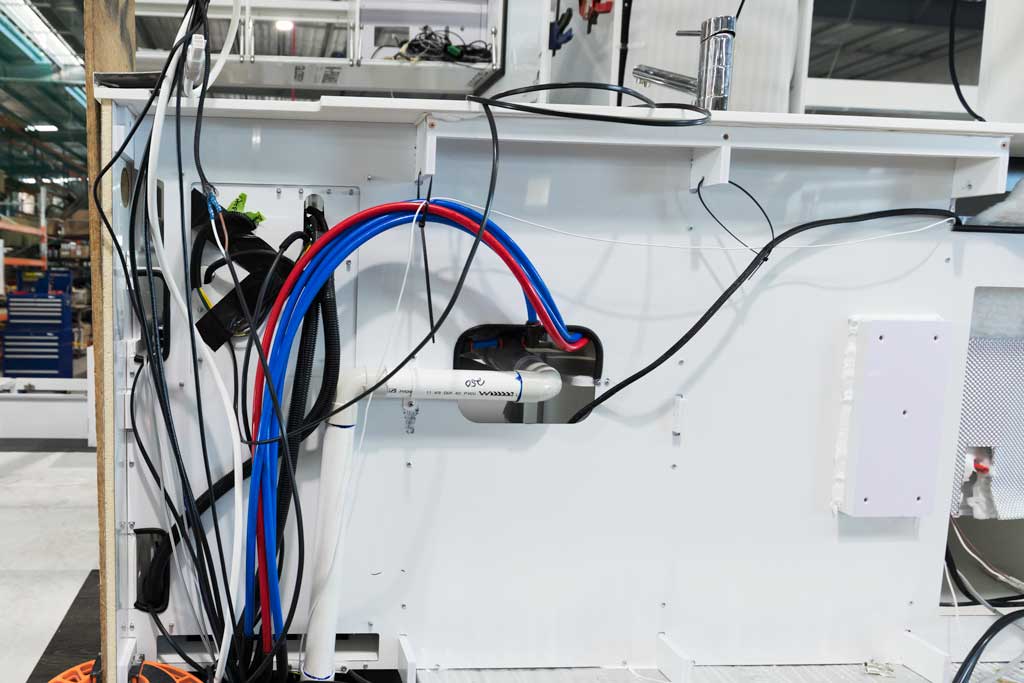


With the full interior completely bonded together and to the floor, the walls and roof are then bonded to the internals. This creates a caravan this is incredibly strong. Only four pieces of composite fibre glass sandwich panels go into making the exterior of the BASE. The single piece roof of the BASE is also the front and back walls. The less joins, the less chance of leaks.
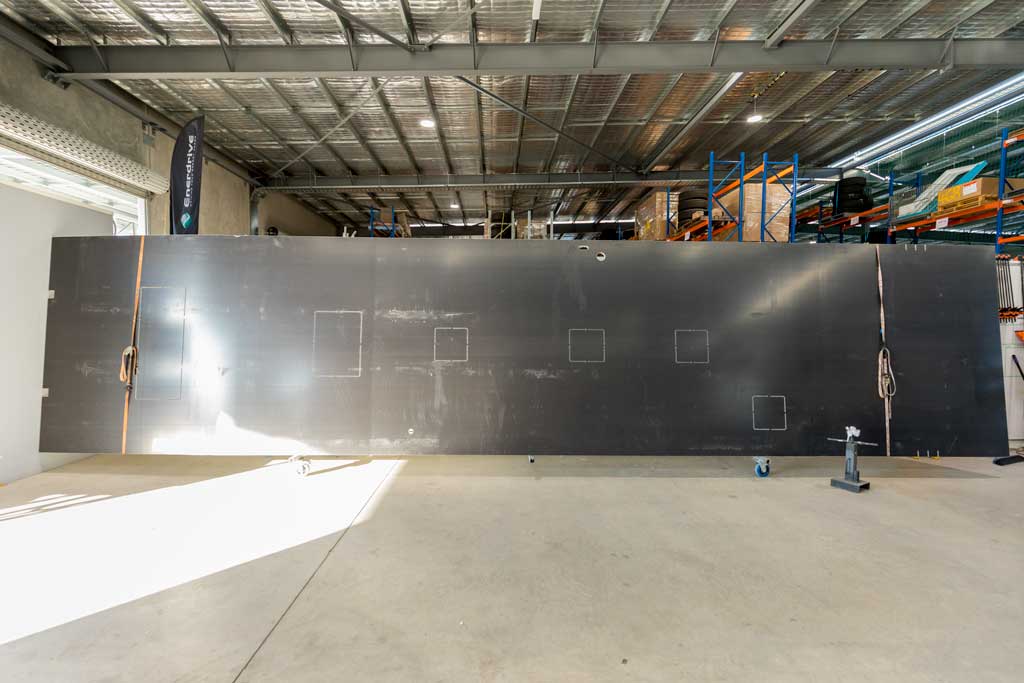


Once cabinets are in and services run, then the single-piece fibreglass walls and roof are bonded to the main caravan structure for maximum strength. Unlike other manufacturers, the single-piece roof of the BASE is also the front and back walls too. Limiting joins limits possible leaks.
THE OUTSIDE OF THE ZONE BASE SERIES
Missing from the BASE Series is the Raptor coating around the lower section of the van walls. The reason for this is that although it is a tough membrane, it can still get damaged and requires maintenance. Also, up to 40 hours of preparation is required prior to it being sprayed. That’s a lot of labour saved, which no doubt benefits the final purchase price.
With the fibreglass panels already being pretty resilient to damage, the Raptor coating was deemed superfluous. If the fibreglass walls do cop a ding, it is able to be easily patch repaired.
For those wanting to spend as much time as possible in the great outdoors, the BASE has you covered with a near full-length awning. Also on the near side under the awning is the AV entertainment area and the fold-down picnic table. A pair of LED lights (white/orange) provide more than adequate illumination.



ZONE offers four different slide-out BBQ options that can be fitted to the front tunnel boot for those that don’t mind a bit of cooking in the wild.
INSIDE THE ZONE BASE SERIES
ZONE has built a reputation for at the forefront of interior styling and design. With the new BASE Series, nothing has changed.
The layout of the van is familiar with a queen bed at the front and full-width ensuite at the rear. However, there are the typical ZONE touches throughout.



With a look more akin to an inner-city apartment, the clean modern lines, recessed LED strip lighting and neutral tones create an inviting refuge. Just perfect after a tough day on corrugated outback tracks.
The large, double glazed windows bring the outside in while offering plenty of light and ventilation. Flyscreens and block out blinds keep the insects at bay and allow a peaceful nights sleep.
The windows are fitted with gas struts, which do away with fiddly thumb screws. The struts were matched perfectly to the weight of the windows so that they could be opened to any position.
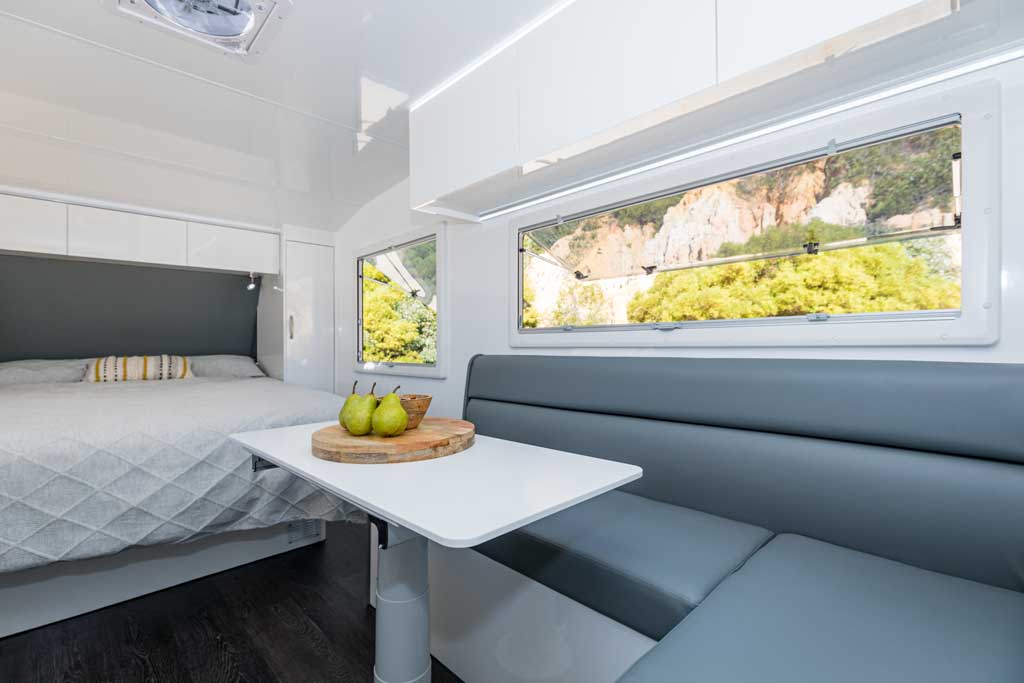


and the large windows let the ‘outside in’
The sleek, galley style kitchen with reconstituted stone benchtop features soft-close drawers and pull-out pantries. A nice touch is the rounded handles used throughout the BASE. These definitely won’t snag your clothes as you walk by.



When it comes time to boil an egg or cook a steak, the Thetford 3-burner gas cooktop will handle the job. If you forget to take out the steak, you’ve got a microwave mounted underneath the bench. A Bushman 180L dual compressor fridge/freezer keeps all your perishables (and maybe a beer or two) cold.
The full-width ensuite keeps with the modern look, with its all-white finish and large vanity mirror creating an illusion of space. The traditional hinged shower door has made way for a far more modern, retractable shower screen, improving access.
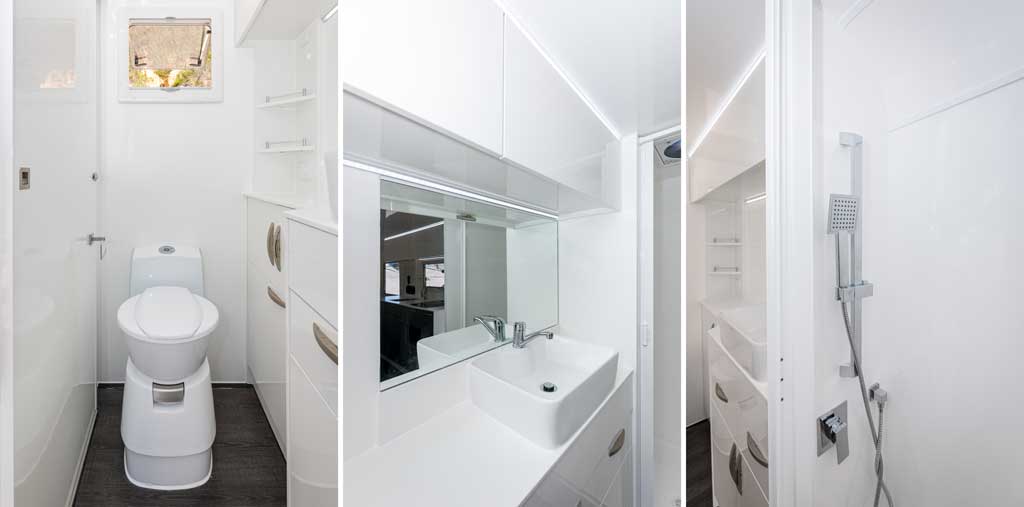


SUSPENSION SYSTEM
Cruisemaster suspension is used exclusively on all ZONE RV builds. Previously, the choice was totally up to you depending on your style of touring, your requirements and your budget.
All BASE vans are fitted with the tried and trusted XT range of independent trailing arm suspension from Cruisemaster. Your choice is whether you want the standard coil fitment, or upgrade to the airbags with manual controls.



Standardising this part of the build keeps the cost down without compromising the ride or towing performance.
ELECTRICAL SYSTEM
The electrical system of the new BASE series differs from models before it by not running an Enerdrive battery management system.
Instead, the BASE Series runs the RedVision TVMS (Total Vehicle Management System) paired with the Manager30 BMS (Battery Management System) from REDARC.
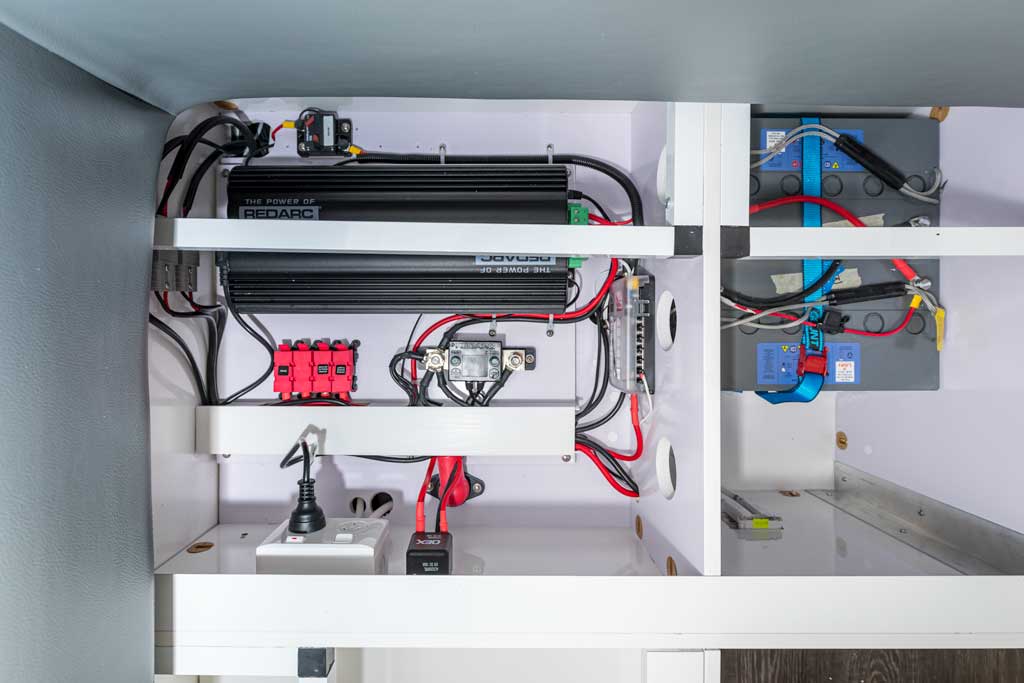


This system keeps the two 120Ah AGM batteries topped up via the two 180W solar panels, the 30A DC/DC charger and 240V battery charger.
However, if you did wish to upgrade the electrical system on your BASE to lithium batteries and inverters, an Enerdrive package is available.
Also found onboard is a Hummingbird GPS trailer Odometer. This unit allows for the caravan to be GPS tracked to accurately record the distance that it has travelled. This will greatly benefit the owner as customisable service intervals can be added. A buzzer alerts the owner when the service interval has been reached.
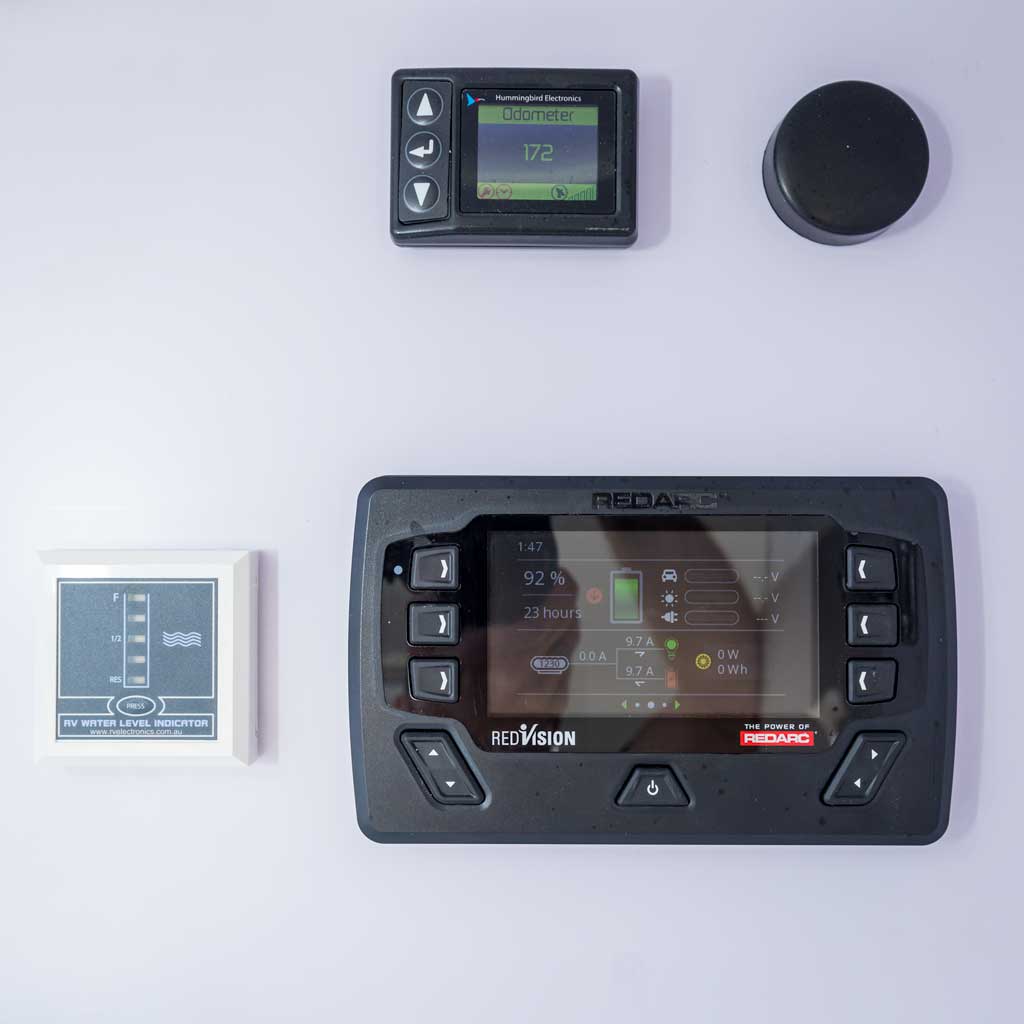


OFF-GRID CAPABILITIES OF THE ZONE BASE
As far as off-grid capabilities go, the BASE Series gives it a pretty good shot but falls short in one area in particular.
If I was to buy a BASE, the first thing I would do would be fit another two freshwater tanks to increase my storage capacity from the standard 90L to 270L. The 100L grey water tank is fine and will allow for forays into National Parks.
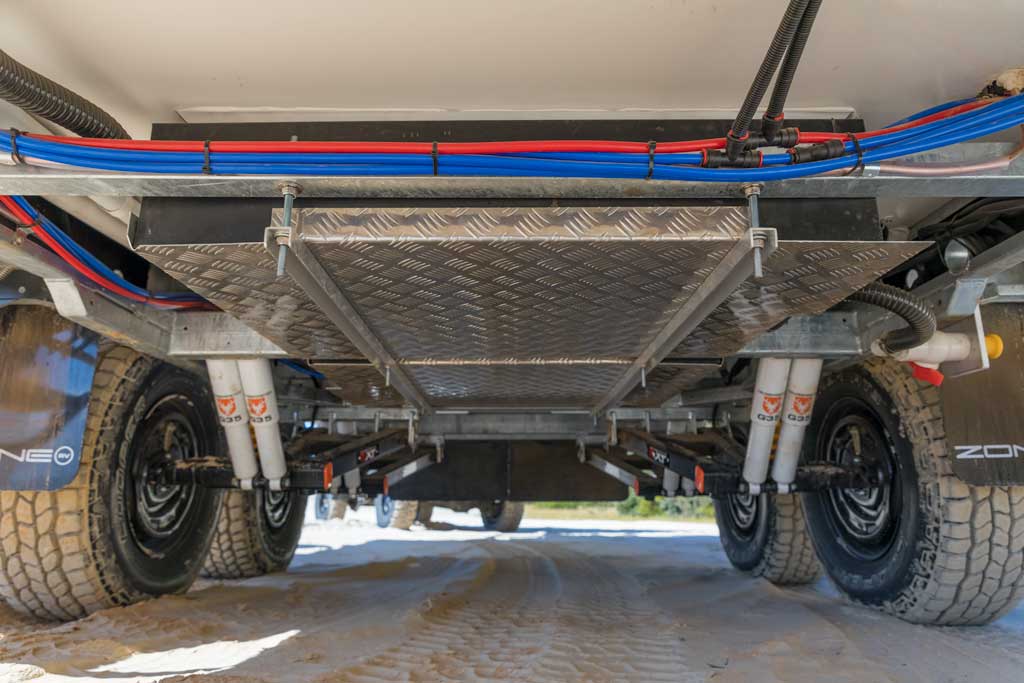


240Ah of battery power will keep you going for a while, especially when the sun’s shining brightly on the 360W of solar panels. Upgrades are available to lithium batteries and an additional 180W solar panel if required.
If you planned on staying in the one place for a long period of time and didn’t already have a generator, this may be an option.
WEIGHTS AND PAYLOAD OF THE ZONE BASE
Due to the lightweight composite materials that ZONE RV use in the construction of their vans, they always have a high payload when compared to vans of a similar size.
The BASE Series is no exception. The 20’6” model on test had a TARE of 2420kg and an ATM of 3500kg. This gives the end-user a payload of 1080kg!
Even adding another 200kg for extra water capacity, most will find it hard to even get close to maxing out their ATM.
That in turn leads to safer towing and less fuel consumption.
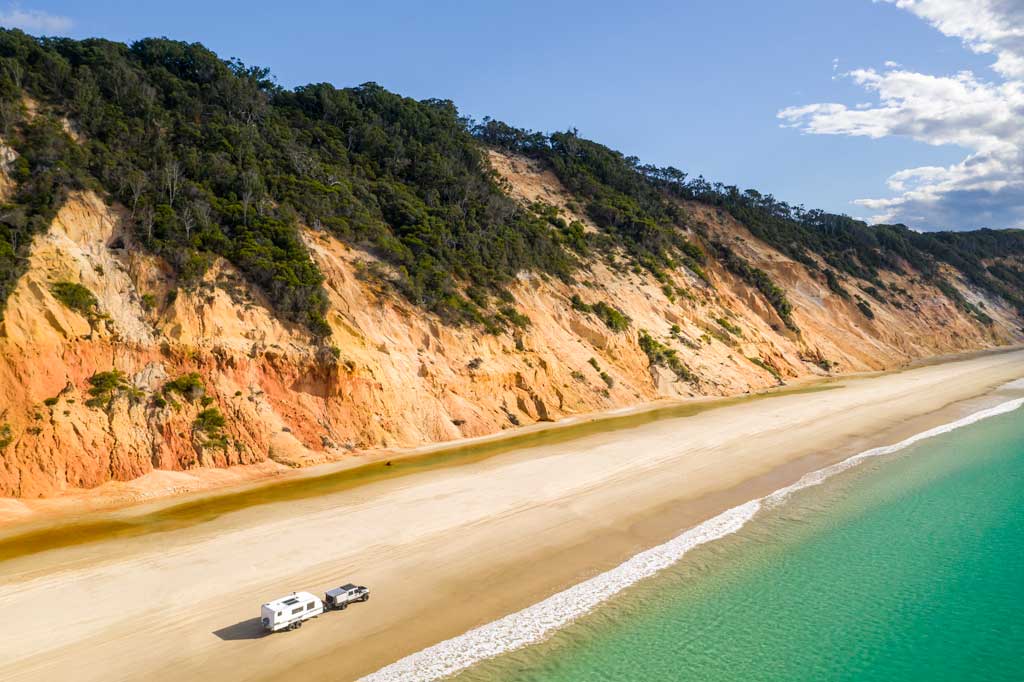


FINAL IMPRESSIONS OF THE ZONE RV BASE SERIES
This is a fantastic caravan with the utmost attention to detail and build quality. To think that you could get yourself into a ZONE RV caravan for under $100k is going to put the new BASE Series on a lot of buyer’s radars.
The BASE Series vans come in a 17′ single axle, an 18’6” and 20’6” dual axle and the 20’6” dual axle family (double bunks) variety.
Pricing starts at $79,900 for the 17’6” with the 20’6” as tested retailing at $89,900. These prices are going to make this premium brand even more accessible than ever.
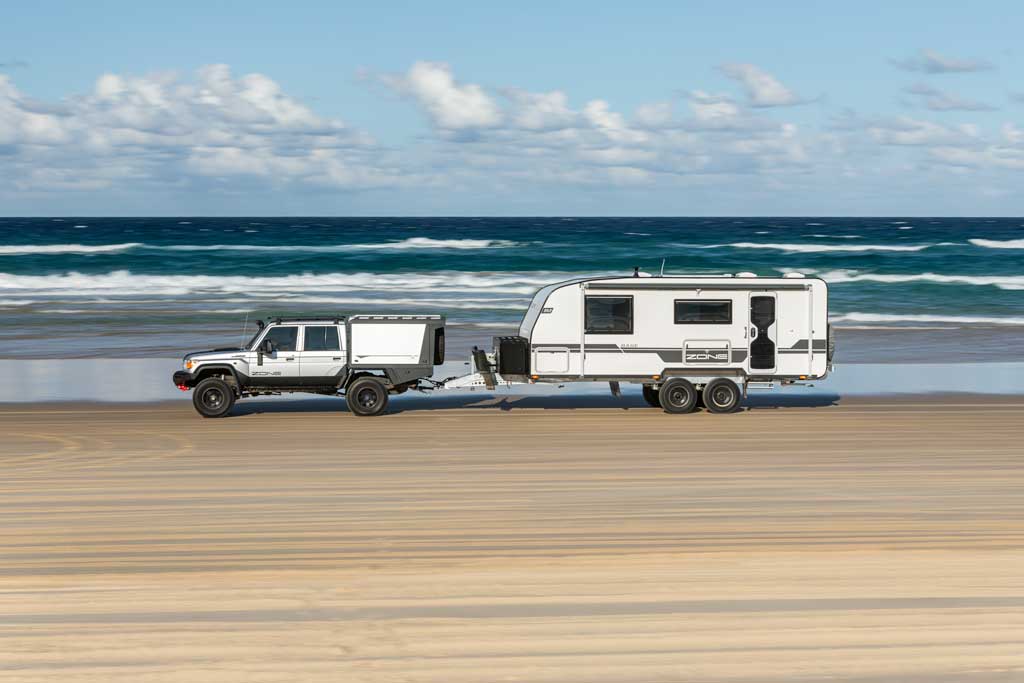


MDLB RATING
It was very hard to find any faults with the ZONE RV BASE, but only having one 90L freshwater tank as standard ensures that this caravan doesn’t get full marks.
The ZONE RV BASE gets 4.5 out of 5 Battered Akubras



HITS
MISSES



SPECIFICATIONS
ZONE RV BASE STANDARD FEATURES
ZONE RV BASE PRICE



About the Author:
Hi, I’m Matt. I camp, four-wheel drive, explore the outdoors and get paid to take photos.
I’m happiest when I’m doing all four at once.
Occasionally, I’ll even tap out a couple of words on my keyboard.
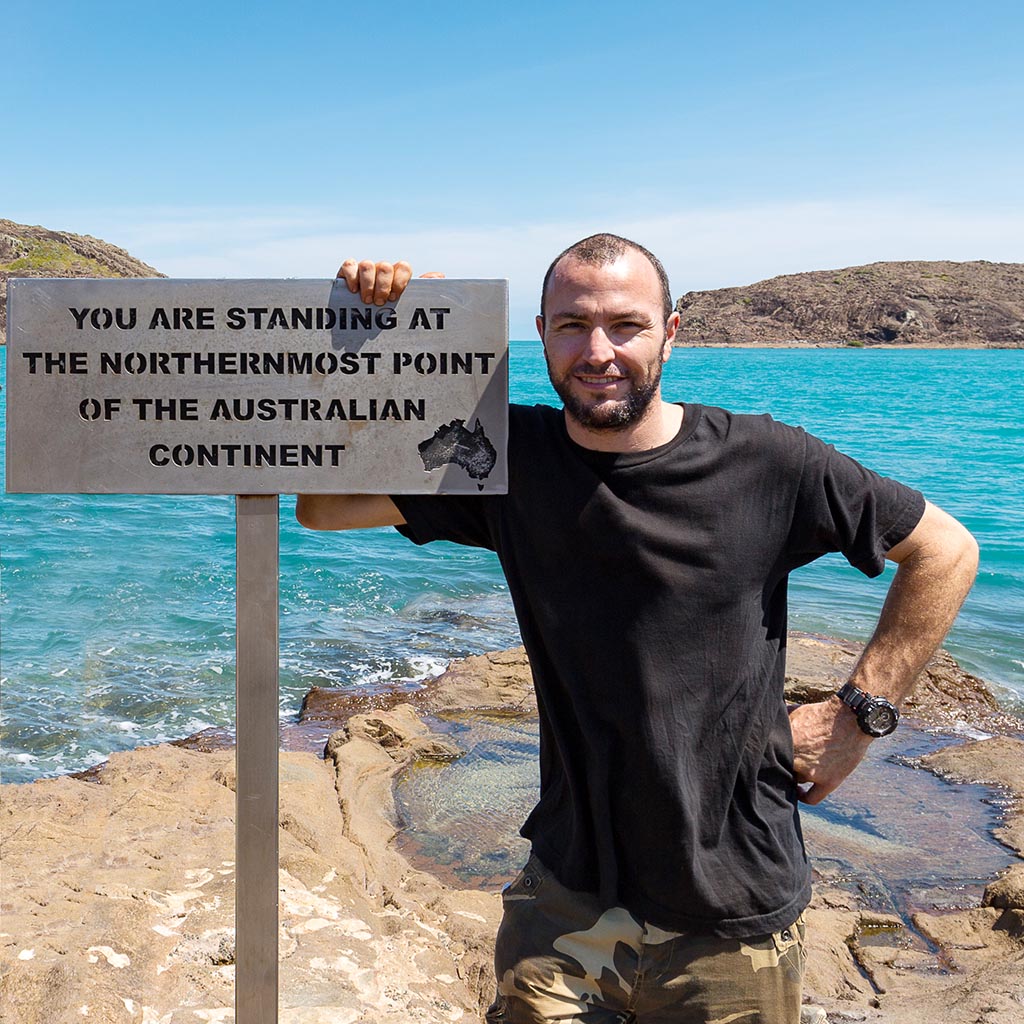


OTHER POSTS YOU MAY LIKE…
JAWA Trax 10 II Review
Over three days and two nights, we put the Jawa Trax 10 Series II Hybrid Camper Trailer through its paces at Queensland‘s beautiful Sunshine Coast Hinterland.
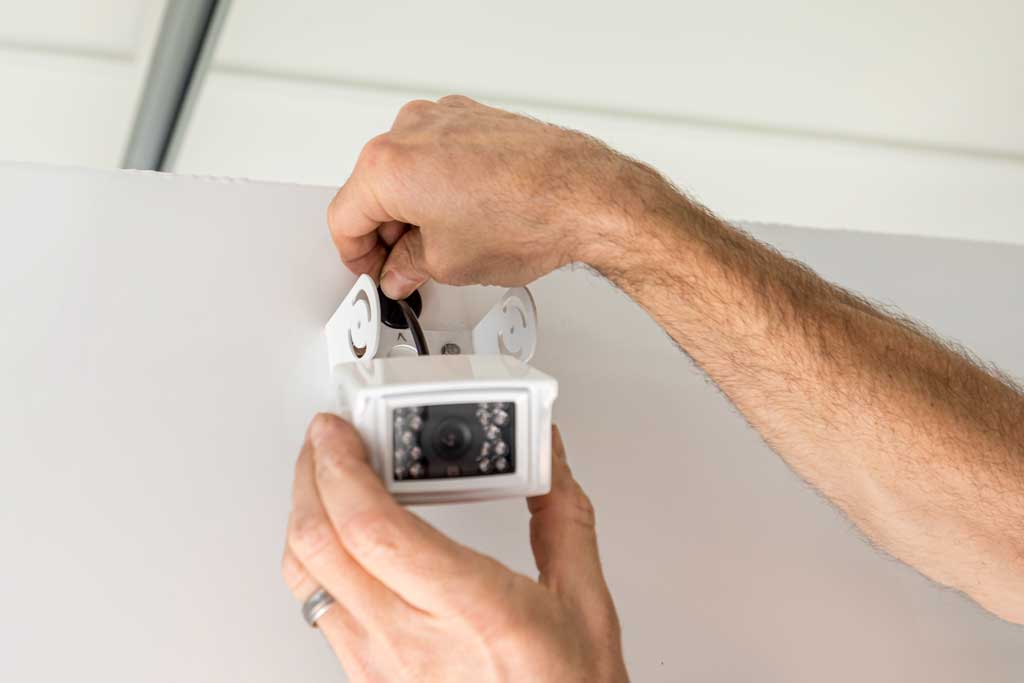

Stanley Mollenhagen says
Yes I agree with the downside being the installation of only one 90L water tank. it needs no less than about 300L .
Another suggestion is the power generating and storage on board. Suggest no less than about 450 generating and 450 storage.
Thanks and Regards
Stan Mollenhagen